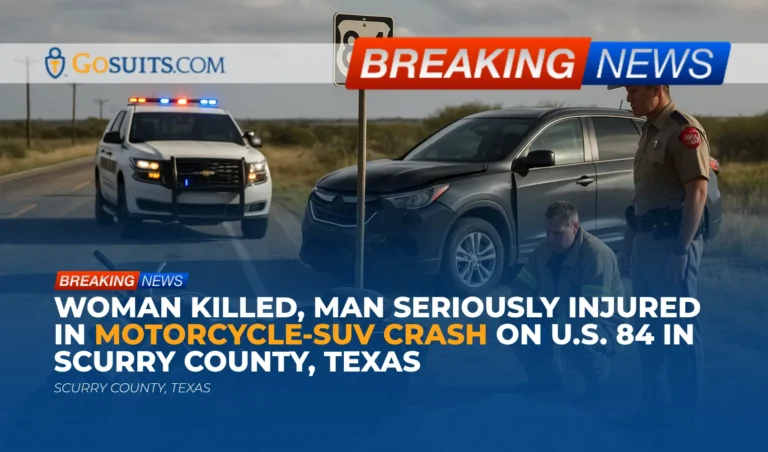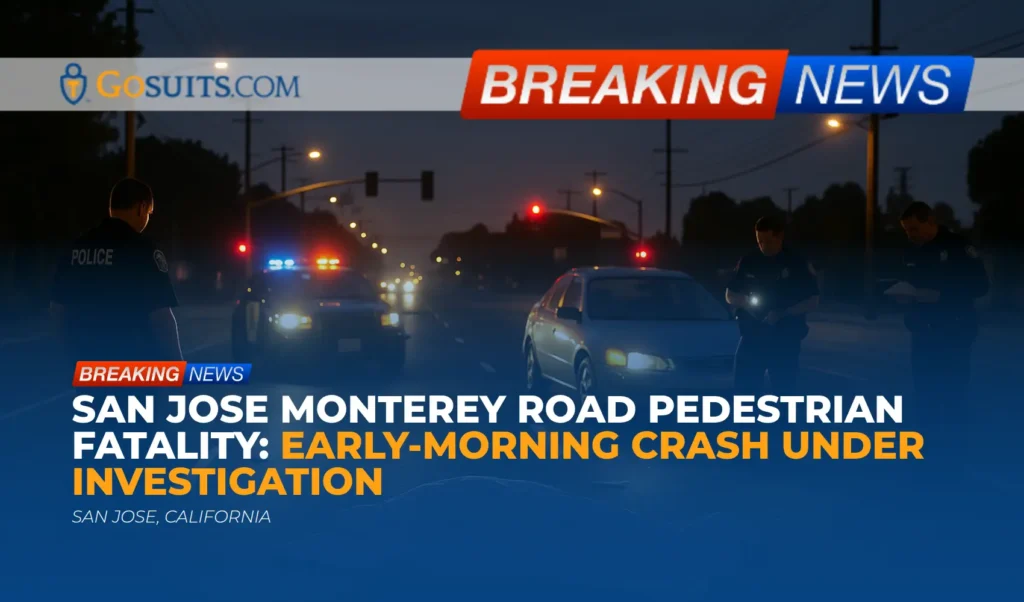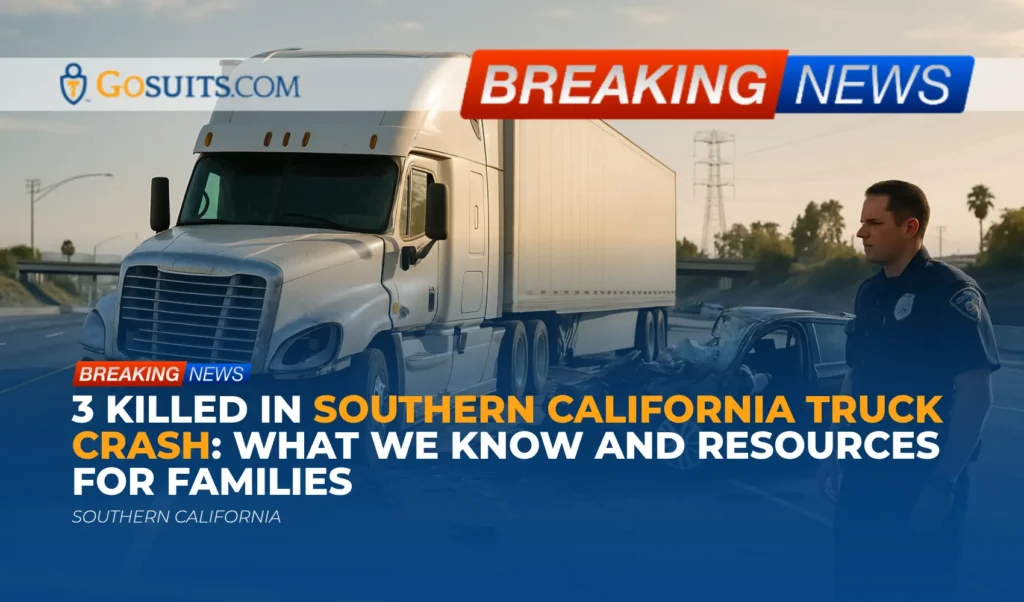- Incident overview and location
- What we know from authorities
- Safety and legal context for motorcycle–SUV intersection collisions
- Potential civil liability pathways
- Insurance considerations after a Texas motorcycle crash
- What families can do now to obtain official records and information
- Practical steps to protect a civil claim
- Commentary from Gosuits Scurry County, Texas Personal Injury Attorney
- Time-sensitive next steps
- Sources and further reading
Incident overview and location
A serious crash involving a motorcycle and an SUV occurred in Scurry County, Texas, on a Thursday, near the junction where Ennis Creek Road meets U.S. Highway 84. According to the Texas Department of Public Safety (DPS), the motorcycle did not slow in time and collided with the SUV as the SUV attempted to enter Highway 84 from Ennis Creek Road. The motorcycle’s driver, a 55-year-old man from Hot Springs, Arkansas, was transported to University Medical Center in Lubbock with serious injuries. A 50-year-old woman riding on the motorcycle was pronounced deceased at the scene. The SUV driver was reportedly uninjured.
Highway 84 is a major corridor through this region. Rural highway access points like Ennis Creek Road can present sightline and speed-differential challenges for both entering vehicles and through traffic. DPS is the primary state agency that investigates roadway crashes outside municipal jurisdictions in Texas.
Who was involved
Per DPS, the driver of the motorcycle was a 55-year-old man from Hot Springs, Arkansas, and the passenger was a 50-year-old woman who tragically died at the scene. Because this event has been publicly reported, names have been shared by authorities, but this summary focuses on facts material to safety and civil law considerations and is mindful of the privacy and dignity of those involved.
Where and when it happened
The collision occurred in Scurry County, Texas, at the access point from Ennis Creek Road to U.S. Highway 84. The precise time of day was not specified in the public report, though the crash occurred on a Thursday.
Agencies involved
Texas DPS is reported as the investigating agency. Emergency medical response resulted in transport to a Level I trauma center in Lubbock. Depending on county resources and the circumstances of the death, a local justice of the peace or a regional medical examiner would be responsible for death investigation and certification.
What we know from authorities
Authorities indicated the motorcycle failed to slow and struck the SUV as the SUV attempted to enter Highway 84. The initial characterization of how a collision occurred is just that: initial. Investigations typically continue to gather physical evidence, witness statements, and data that can clarify vehicle positions, speeds, and driver behavior prior to impact.
Ongoing investigation considerations
In similar investigations, data sources may include:
- Scene evidence: skid or yaw marks, debris fields, gouges, and final rest positions of vehicles.
- Vehicle inspections: brake condition, lighting, mechanical issues, and, for newer vehicles, event data recorder downloads.
- Visibility and environment: line of sight at the access road, lighting conditions, signage, weather, and roadway geometry.
- Third-party information: surveillance cameras from nearby properties or dash cameras.
Initial reports help the public understand the basics. A full analysis often adds nuance about who had the right-of-way at the moment of conflict, whether each driver was maintaining a prudent speed and lookout, and whether roadway design or signage played a role.
Safety and legal context for motorcycle–SUV intersection collisions
Intersections and access points to high-speed highways are frequent sites of severe motorcycle crashes. Even a momentary misjudgment in gap acceptance by an entering vehicle or a slight delay in slowing by a through-traveling motorcycle can have catastrophic consequences given the exposure of motorcyclists.
Common contributing factors in these collisions
- Gap acceptance errors: Drivers entering a highway sometimes misjudge the time and distance of oncoming traffic, especially motorcycles, which can be harder to detect and may appear farther away or slower than they are.
- Speed differentials: Vehicles on the highway often travel at or near highway speeds, reducing reaction time if an entering vehicle pulls out.
- Line-of-sight limitations: Curves, grades, vegetation, and signage can limit visibility at access points.
- Perception-response time: A rider who encounters a suddenly intruding vehicle has only seconds to brake or swerve, and motorcycles are more vulnerable to loss of stability under hard braking or abrupt maneuvers.
Motorcycle risk and injury data
National roadway safety data consistently show that motorcyclists face higher risks of severe injury and death per mile traveled than occupants of passenger vehicles. Federal safety agencies emphasize visibility, speed management, and protective gear as key risk mitigators. See the National Highway Traffic Safety Administration’s motorcycle safety materials for national trends and prevention strategies, and the Centers for Disease Control and Prevention overview on motorcycle safety for injury prevention guidance.
Helmet and training laws in Texas
Texas law requires motorcycle riders and passengers under age 21 to wear helmets. Adults over 21 may ride without a helmet if they meet certain training or insurance criteria. Helmet use is a critical safety measure associated with reductions in head injury severity. While the presence or absence of a helmet may be documented in crash reports, civil liability determinations focus primarily on the conduct of each party and applicable traffic duties.
Potential civil liability pathways
Texas civil law centers on whether each party used reasonable care and followed applicable rules of the road. At an access point to a highway, drivers entering from a side road generally must ensure it is safe to proceed and yield to vehicles already on the main roadway. Conversely, through traffic must maintain a prudent speed, keep a proper lookout, and take reasonable action to avoid a collision when hazards appear. Investigations look at both sides, and it is not unusual for responsibility to be shared in some proportion.
Comparative fault in Texas
Texas follows a modified comparative responsibility framework. If a claimant’s percentage of responsibility is greater than 50 percent, they cannot recover from others. If the claimant is 50 percent or less responsible, recoverable damages are reduced by their percentage of responsibility. The statute governing proportionate responsibility is in the Texas Civil Practice and Remedies Code Chapter 33. Understanding how insurers and courts assess percentages of fault is essential to evaluating a claim’s viability.
Wrongful death and survival claims
When a fatality occurs, Texas law provides two related civil claims:
- Wrongful death: Brought by certain statutory beneficiaries, typically the surviving spouse, children, and parents. This action seeks damages personal to those family members for the impact of the loss. See the Texas Civil Practice and Remedies Code Chapter 71.
- Survival action: Brought on behalf of the decedent’s estate for claims the decedent could have asserted had they lived, such as conscious pain and suffering and certain medical expenses. Also governed by Chapter 71.
These actions are distinct, may be pursued together, and have different measures of damages and distribution rules. Coordination with probate considerations is often part of survival claims, since they proceed through the estate.
Statute of limitations
In Texas, the general statute of limitations for personal injury and wrongful death claims is two years from the date of injury or death. Some exceptions may apply, but they are narrow and fact specific. See Texas Civil Practice and Remedies Code Section 16.003. Acting within the applicable deadline is crucial to preserve rights.

Roadway design and signage considerations
Separate from driver conduct, certain crashes may prompt a review of signage, sight distance, or road design. Claims involving roadway design have special notice and immunity issues when governmental entities are involved, and shorter deadlines for notice can apply. These issues require careful, early evaluation.
Insurance considerations after a Texas motorcycle crash
Insurance coverage can involve multiple policies and states, especially when an Arkansas resident is injured in Texas. Key coverage types and issues often include:
Liability coverage
Texas requires minimum liability coverage for drivers. If the SUV driver is found partly or fully at fault, their liability policy may respond. Conversely, if the motorcyclist is assigned some responsibility, that will factor into how claims are presented and resolved. See consumer guidance from the Texas Department of Insurance on required coverages and how claims are handled.
Uninsured/underinsured motorist and PIP
- Uninsured/Underinsured Motorist (UM/UIM): Designed to protect people when the at-fault driver lacks insurance or lacks enough insurance. UM/UIM is offered in Texas unless properly rejected in writing, and many policies issued in other states also include it. UM/UIM can apply even when the crash occurs outside the policyholder’s home state, depending on policy language.
- Personal Injury Protection (PIP): In Texas, PIP pays for certain medical costs and lost income regardless of fault, unless it was rejected. It is separate from health insurance and can coexist with UM/UIM claims in a serious crash.
The Texas Department of Insurance provides plain-language explanations of these coverages and how to open a claim. Getting legal guidance before recorded statements can help avoid misunderstandings that complicate coverage decisions.
Cross-state policies and coordination
When an out-of-state resident is injured in Texas, policy coordination can involve Texas law, the home-state policy terms, and choice-of-law issues. Insurers may apply jurisdiction-specific provisions, and medical providers may assert liens under Texas law even if the patient resides elsewhere. Early review of all potentially applicable policies helps identify benefits that can be accessed promptly.
Hospital and EMS liens
Texas law allows hospitals, emergency medical services, and certain trauma facilities to file liens on a patient’s cause of action for injuries treated within a defined time after the crash. These liens attach to portions of any third-party recovery and must be addressed before funds are disbursed. See Texas Property Code Chapter 55 for the hospital lien framework. Understanding lien validity criteria and itemized charges can affect how net proceeds are distributed.
What families can do now to obtain official records and information
After a serious crash, obtaining official documents can clarify what happened and support insurance or civil claims. The following resources and steps are commonly useful in Texas.
Order the official Texas crash report
- Who keeps the report: Most Texas crash reports are filed with the Texas Department of Transportation (TxDOT).
- How to order: The report can typically be purchased through TxDOT’s Crash Records Information System (CRIS) online portal. You will need at least one of the following: the legal name of a person involved, the date of the crash, or the location.
- What it contains: Officer’s narrative, diagram, contributing factors, and unit information. Supplemental reports may be added later.
Access the TxDOT crash report information and purchase portal at the TxDOT website.
Request supplemental records from the investigating agency
- 9-1-1 audio, body-worn camera, dash camera: These may be requested under the Texas Public Information Act. Some items may be withheld or redacted depending on the investigation’s status and privacy laws.
- Scene photographs and measurements: Availability varies by agency and case status. Requesting in writing and referencing the crash date, location, and involved parties helps agencies locate records.
- Who to contact: For rural crashes, Texas DPS typically holds investigative files. DPS and local sheriff’s offices also maintain Public Information Act request processes.
General guidance on open records requests, exemptions, and timelines is maintained by the Office of the Texas Attorney General.
Obtain medical records from treating providers
- Right to access: Patients and authorized representatives have a federal right to access medical records and can request copies directly from hospitals and EMS providers.
- How: Contact the provider’s Health Information Management (HIM) or Medical Records department. Written authorization and proof of authority may be required for an incapacitated patient or for the records of a deceased individual.
- Tip: Ask for itemized billing and radiology imaging along with clinical records; these can be important for insurance and civil evaluations.
The U.S. Department of Health and Human Services explains patient access rights under federal law.
Death certificate and autopsy information
- Death certificates: In Texas, certified copies are issued through the Texas Department of State Health Services Vital Statistics office or through county offices that serve as local registrars.
- Autopsy: In counties without a dedicated medical examiner, a justice of the peace typically oversees death investigations and may arrange an autopsy at a regional facility when required by law or warranted by circumstances.
- Who to call: Contact the relevant county authority handling deaths in the county where the crash occurred. In many rural areas, that is the Justice of the Peace. They can advise where records are maintained and what documentation is needed.
For general state guidance on death records, visit Texas DSHS Vital Statistics.
Practical steps to protect a civil claim
These steps can help preserve rights and avoid preventable missteps. In serious-injury and fatal cases, the earlier these are started, the better.
- Consult a qualified personal injury attorney first: Before contacting any insurance company, speak with an attorney for a free consultation to understand rights and obligations. Statements to insurers can be recorded and may be used later in ways that are not obvious at the time.
- Preserve evidence: Secure the motorcycle and rider gear in their post-crash condition. Do not authorize disposal or repairs until counsel and an expert can inspect. Preserve any available dash-cam or third-party video.
- Identify witnesses: Write down names and contact information of anyone who saw the crash or its aftermath. Independent witnesses can be critical.
- Document injuries and losses: Maintain a running log of medical symptoms, appointments, travel for care, and out-of-pocket expenses. Keep copies of pay stubs and employer letters for time missed from work.
- Manage medical billing: Request itemized statements and keep track of health insurance explanations of benefits. Verify any hospital or EMS liens filed under Texas law and confirm amounts and dates of service.
- Be careful on social media: Posts can be misconstrued or taken out of context. It is prudent to avoid public discussion of the crash or injuries.
- Calendar deadlines: Note the two-year statute of limitations that generally applies to personal injury and wrongful death in Texas. Shorter notice deadlines may apply if any government entity’s actions are implicated.

Commentary from Gosuits Scurry County, Texas Personal Injury Attorney
Our hearts are with the individuals and families affected by this tragedy in Scurry County. A sudden loss on a rural highway leaves deep grief and many unanswered questions. This commentary is offered for educational purposes and general information.
Based on what has been publicly shared, this appears to be a highway access collision at Ennis Creek Road and U.S. 84, an environment where even small timing errors can have devastating outcomes for a motorcyclist. Responsible investigation focuses on both vehicles: whether the entering vehicle had a safe gap and adequate visibility, and whether the motorcycle’s speed, braking, and lookout were consistent with ordinary care. Physical evidence, time-distance calculations, and any electronic data downloads can help answer these questions more definitively than initial narratives alone.
In the aftermath, insurance carriers often move quickly to record statements and shape fault assessments before all evidence is collected. Early communications may include broad medical authorizations or questions framed in ways that seem routine but can influence coverage and liability decisions. Large corporations and insurers are practiced in this process. Individuals navigating it for the first time, especially while dealing with injury or grief, may not realize how a few words can be later interpreted. Taking time to understand rights, the comparative responsibility rules in Texas, and the role of coverages like UM/UIM and PIP can prevent unintended harm to a potential claim.
A free consultation with a seasoned attorney can help clarify the path forward, from ordering the TxDOT crash report and supplemental files to coordinating benefits across state lines and addressing hospital liens. It does not commit anyone to a course of action, but it can bring calm and structure to a difficult time.
Time-sensitive next steps
The following actions can help ensure important rights and evidence are preserved while decisions are considered.
- Within the next 72 hours: Write down your recollection of events while details are fresh. Identify and preserve any physical evidence, rider gear, and electronic data. Note the exact crash location and any potential surveillance cameras in the area.
- Within the next week: Order the official crash report through TxDOT’s CRIS portal and request any available supplemental records from the investigating agency. Ask treating providers for itemized medical bills and copies of imaging and lab results.
- Before speaking to insurers: Schedule a free consultation with a qualified personal injury attorney to understand Texas comparative responsibility, available coverages, and the impact of recorded statements. What is said to any insurer can be used later, sometimes out of context.
- In the first month: Evaluate all potentially applicable policies, including the motorcycle policy, any household policies with UM/UIM, and med-pay or PIP. Verify whether any hospital or EMS liens were filed and confirm their accuracy.
- Ongoing: Keep a centralized file of all documents, receipts, and correspondence. Maintain a treatment journal to track symptoms and functional changes; this can be helpful for providers and for any later evaluation of damages.
Acting sooner rather than later can improve access to evidence, reduce administrative delays, and help avoid inadvertent missteps that affect a claim.
Sources and further reading
- Texas Department of Transportation: Crash reports and CRIS purchase portal
- Texas Civil Practice and Remedies Code Chapter 33: Proportionate Responsibility
- Texas Civil Practice and Remedies Code Chapter 71: Wrongful Death and Survival
- Texas Civil Practice and Remedies Code Section 16.003: Two-year limitations
- Texas Property Code Chapter 55: Hospital and Emergency Medical Services Liens
- Texas Department of Insurance: Auto insurance basics
- Texas Department of Insurance: Understanding auto insurance coverages
- National Highway Traffic Safety Administration: Motorcycle safety
- Centers for Disease Control and Prevention: Motorcycle safety
- U.S. Department of Health and Human Services: Right to access medical records
- Texas Department of State Health Services: Death records
- Texas Attorney General: How to make a Public Information Act request






